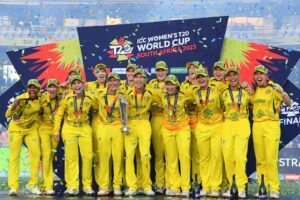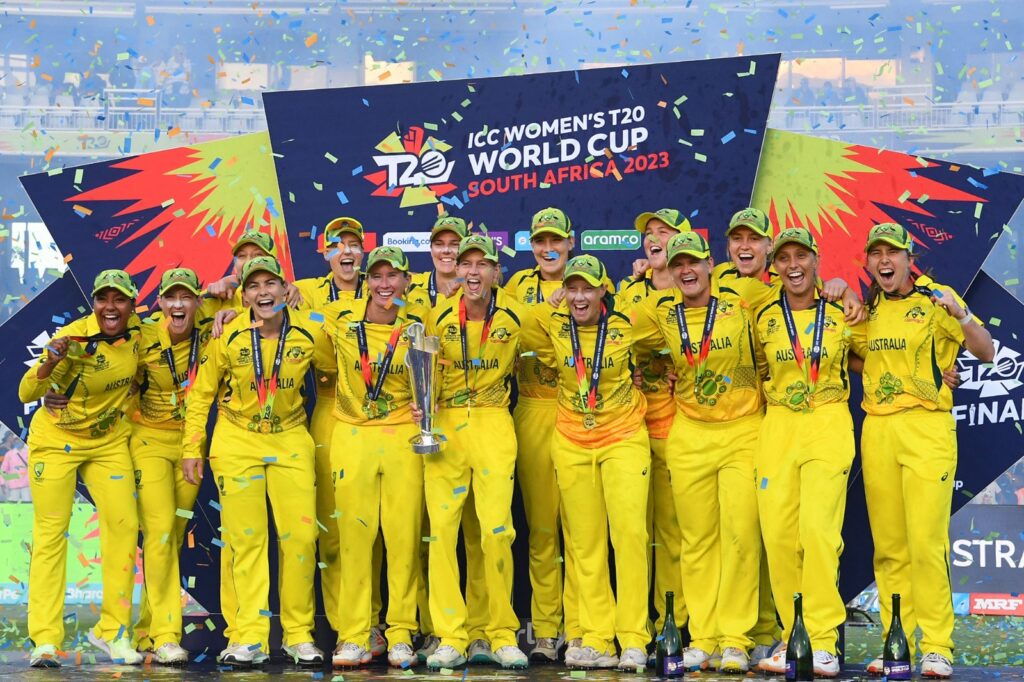
Rather than being dismayed by their loss, South Africa should look to Australia for inspiration. Lanning’s team is perhaps the most dominant sports side in the world right now, proud torchbearers of a great tradition.
On February 26, in the women’s World T20 final at Newlands, Ellyse Perry and Meg Lanning scored just 17 runs off 16 balls. Megan Schutt took one wicket, but also conceded four of the 11 fours that South Africa struck during the run chase. Perry bowled just one wicket-less over for five runs. Jess Jonassen was whacked for two sixes in her three overs.
What, you may well ask, is the significance of these obscure figures? Well, if ypu go back exactly a decade to another World Cup final, the 50-overs version at the Brabourne Stadium in Mumbai, you’ll find three of those four names on the scorecard. Lanning scored 31, and Perry 25 out, and Perry then destroyed the West Indian chase with 3-19. Schutt took 2-38 and was the leading wicket-taker in the competition.
The Newlands triumph was Perry’s sixth in the World T20. SIXTH. Just let that sink in. Player of the match in the 2010 final when Australia defended a total of 106, she was subsequently voted Women’s ODI Cricketer of the Decade and Women’s T20I Cricketer of the Decade. She isn’t just cricket royalty. She is the queen, and Australia have won this World Cup with next to no significant contribution from her.
For Lanning and Jonassen, this was a fifth World T20 title, going back to 2012. For Schutt, whose four wickets scuttled the Indian chase of a monumental target in 2020, this completed a hat-trick of titles.
But if you think these experienced stalwarts were passengers in 2023, think again. Lanning’s cool captaincy was pivotal as South Africa’s chase unravelled in the setting sun at Newlands. The decision to promote Ashleigh Gardner to Lanning’s usual spot at No.3 gave Australia’s batting innings the shot of momentum it needed after a fairly subdued Power play.
It was Schutt that pinned Laura Wolvaardt deep in her crease for the key dismissal in the second innings. Jonassen then took out the dangerous Chloe Tryon. As for Perry, there wouldn’t even have been a final without her fielding heroics on the boundary in the semi-final against India.
And what can you say of Beth Mooney, who followed up her classy unbeaten 54-ball 78 in the 2020 defeat of India with 74 not out from 53 balls at Newlands? The South Africans knew Mooney’s strength was on the off side, and often packed the area with five women, but she still scored 45 runs in the arc between mid-off and third man. It was extraordinarily precise batting, and ultimately match-winning.
When you lose a final in such heart-breaking circumstances, as South Africa did in front of their home crowd, it’s customary to talk of the wounds it may leave on the psyche. But in this case, this appearance in the final may just be the spur the sport needs to take it to the next level in the rainbow nation.
The magnificent Shabnim Ismail and Marizanne Kapp were part of South Africa’s playing XI at the 2013 World Cup in India, with Kapp making 61 and Ismail taking 4-41 as Australia edged a close game in the group stage. South Africa’s only wins in that tournament came against Pakistan and Sri Lanka, and it was a stretch to even mention them in the same breath as Australia.
In terms of resources, the two sides aren’t remotely equal. It was only in 2014 that half a dozen South African girls got central contracts. Till then, most of them had to juggle their matches for the national side with regular jobs. Cri-zelda Brits, who captained the side for a while in the noughties, now works as an IT professional in Hong Kong. Many others fell by the wayside simply because cricket couldn’t put food on their tables.
In contract, the Women’s Big Bash League in Australia has just finished its eighth season. Perry gave up playing soccer for the Matildas because she was convinced that a top-flight cricket career could prove lucrative enough. There is also a culture of excellence that goes back decades.
When you see Lanning or Mooney bat, you’re seeing the latest links in a chain that extends back to Belinda Clark and Karen Rolton, through Lisa Sthalekar and Rachel Haynes. When Darcie Brown rattles batters with her pace, she’s carrying forward a tradition that goes back to the great Cathryn Fitzpatrick, which has then been taken forward by the likes of Perry, Schutt and Julie Hunter.
Gardner, who has already crossed 1000 runs in the T20I format and was player of the match in the 2018 final before being named Player of the Tournament here, is a bigger-hitting version of Sthalekar, whose all-round skills guided Australia for a generation. Make no mistake, this is not just a great sports team, it’s a dynasty.
In March 2003, India’s men lost a World Cup final to a legendary Australian side in the middle of a streak that would see them win three straight 50-over World Cup. Eight years later, in a titanic tussle in Ahmedabad, India would get payback on their way to a second world title. It may be too late for Kapp and Ismail, but the younger women in the side can use Sunday’s loss as motivation for what lies ahead. Australia’s women, perhaps the most complete and dominant sports team in the world right now, have shown them just how high the bar has to go.




